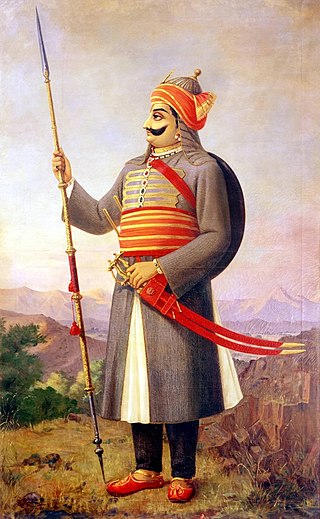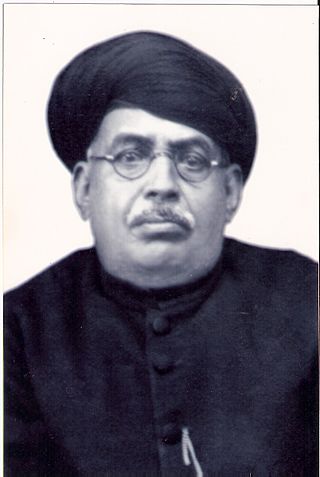
Pratap Singh I, popularly known as Maharana Pratap, was a king of Kingdom of Mewar, in north-western India in the present-day state of Rajasthan. He is notable for leading the Rajput resistance against the expansionist policy of the Mughal Emperor Akbar including the Battle of Haldighati.

Gaurishankar Hirachand Ojha, born in Rohida village of Sirohi District, was a historian from the Indian state of Rajasthan. A prolific author, he wrote several books on the history of Rajasthan and other historical subjects. Subsequent historians from Rajasthan have referred to him as Guruvara Mahamahopadhyaya. Ojha regarded Kaviraj Shyamaldas as his guru and worked under him as assistant secretary of the historical department, Udaipur

Sawai Madho Singh I was the Kachwaha Rajput ruler of the Kingdom of Jaipur. He was the younger son of Maharaja Sawai Jai Singh II and younger half brother of Sawai Ishvari Singh. He became ruler of Jaipur after his brother Sawai Ishvari Singh died in 1750.

Rājputana, meaning Land of the Rajputs, was a region in the Indian subcontinent that included mainly the present-day Indian state of Rajasthan, as well as parts of Madhya Pradesh and Gujarat, and some adjoining areas of Sindh in modern-day southern Pakistan.
Rajasthani literature is an tradition in Indian literature dating to the 2nd millennium, which includes literature written in the Rajasthani language. An early form of Rajasthani started developing in the 11th century from Saurseni Prakrit as Maru-Gurjar or Gurjar Apabhramsa. Early Rajasthani literature was usually written by Charans. Earlier Rajasthani was known as Charani or Dingal, which was close to Gujarati. Medieval Rajasthani literature was mostly heroic poetry mentioning the great kings and fighters of Rajasthan. Rabindra Nath Tagore, a Bengali polymath, once said, "The heroic sentiment which is the essence of every song and couplet of a Rajasthani is peculiar emotion of its own of which, however, the whole country may be proud". It is generally agreed that modern Rajasthani literature began with the works of Suryamal Misran, including the Vansa Bhaskara and the Vir Satsai. The Vansa Bhaskara contains accounts of the Rajput princes who ruled in what was then Rajputana, during the lifetime of the poet (1872–1952). The Vir Satsai is a collection of hundreds of couplets.

Fateh Singh, was the Maharana of the Sisodia dynasty of Mewar i.e Princely State of Udaipur for nearly 46 years from the year 1884 to 1930, with Udaipur as his capital, and resided in the grandiose City Palace, Udaipur.
Muhnot Nainsi (1610–1670) was a medieval historian and Dewan of Rathore ruler Jaswant Singh of Marwar. He is known for his studies of the region now encompassed by the state of Rajasthan in India. He was son of Jaimal Muhnot, who was Senior Office holder under reign of Sur Singh and Gaj Singh Early in his professional career, Nainsi was appointed successively as the hakim of various parganas in Marwar. The extensive, first-hand knowledge he collected of the region informed his later writings. In 1658, he was appointed dewan of Marwar, in which position he served until 1666. The literary works he is most known for are Marwar Ra Pargana Ri Vigat and Nainsi Ri Khyat.
Thakur Kesari Singh Barhath was an Indian revolutionary leader, freedom fighter, and educator from the state of Rajasthan. He was the patriarch of the Barhath family, members of which participated in anti-British activities Barhath was also known as Rajasthan Kesari.
Kaviraj is a title of honor, which was given to poets and litterateurs attached to royal courts in medieval India. Eminent Charans who were inducted into the royal courts due to their literary merit as royal poets and historians were given the rank of Kaviraja. Such Charans assumed positions of great influence in the medieval polity. Few well known people are Kaviraja Shyamaldas, Kaviraja Bankidas, etc. The descendants of such persons also started using the surname, Kaviraj.

Maharana Pratap: The First Freedom Fighter is an Indian epic film based on Maharana Pratap of Mewar .The film is directed and produced by Dr. Pradeep Kumawat from Udaipur, Rajasthan. It is the first time that a film has been made on the history of Maharana Pratap. The film's sound track includes one of the last songs sung by Late Jagjit Singh.

Maharana Raj Singh I, was the Maharana of Mewar Kingdom and eldest son of Maharana Jagat Singh I. He fought against Mughal Empire and annexed many Mughal territories He participated in Rajput-Mughal War (1679–1707) and defeated the Mughals.
Bhomat is a mountainous and forested area in southern Rajasthan, covering all or parts of the tehsils of Kotra, Jhadol and Kherwara in Udaipur district. During British rule, the region was also referred to as 'Hilly Tracts of Mewar'.

The Mewar Bhil Corps is a state armed police force of the Rajasthan Police. The Corps was originally raised by the British Indian government as a military unit along similar lines as units such as the Merwara Battalion and Malwa Bhil Corps. The Corps operated as a regular unit of the British Indian Army until 1938; since then it has been maintained as a para-military force.
Battle of Bandanwara was fought between Mewar and Mughal forces in 1711 AD, between Hurda and Bandanwara, near Khari river in Bhilwara district, Rajasthan.
Chetavani ra Chungatya is a patriotic Dingal poem composed by Thakur Kesari Singh Barhath in 1903 and addressed to Maharana of Mewar, Fateh Singh, exhorting him to uphold the traditions of his lineage and to not attend the Delhi Durbar. The couplets had the desired effect on the Maharana who decided not to attend the durbar despite being present in Delhi. The work remains one of the great literary works produced during the freedom struggle. It consists of 13 stanzas or sortha (saurashtra-duha).
Sasan was a tax-free land grant given in the form of either partial or whole villages to the Charanas by rulers in medieval India. These grants were given in perpetuity and enjoyed superior rights compared to other land tenures.
Dadhivadia is a clan of Charanas of Rajasthan. It is also used as a surname.








